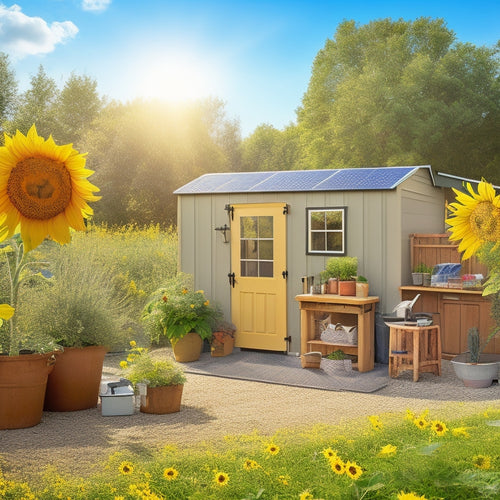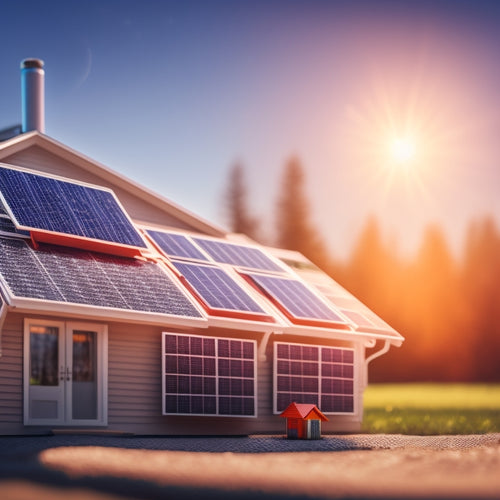
What Energizes Your Home's Automation System?
Share
You're likely wondering what powers your home's automation system. The answer lies in utilizing renewable energy sources like solar and wind power. By integrating these clean energy sources with advanced battery storage systems, you can reduce your reliance on non-renewable energy sources and lower your carbon footprint. Solar panels, in particular, can generate electricity, which is then stored for later use. Understanding the components and benefits of DIY solar installation, proper charging mechanisms, and energy efficiency gains are key to maximizing your system's performance. As you investigate these elements, you'll access the full potential of your home's automation system.
Overview
- Solar panels convert sunlight into electrical energy, powering home automation systems and reducing reliance on non-renewable sources.
- Wind energy serves as a clean and abundant resource for electricity generation, suitable for off-grid living and automation systems.
- Battery storage systems store excess energy generated by solar panels or grid connections, ensuring a reliable power supply for automation systems.
- Smart chargers optimize energy transfer, prevent overcharging, and protect battery health, ensuring the automation system remains functional without downtime.
- Proper integration of renewable energy sources and energy storage systems enables efficient and sustainable power supply for home automation systems.
Harnessing Renewable Energy Sources
You can greatly reduce your reliance on non-renewable energy sources by integrating your home automation system with renewable energy sources. This integration allows you to utilize the power of wind energy, a clean and abundant resource.
Additionally, off-grid solar power systems can also contribute to a cleaner environment and lower carbon footprints for rural homes Off-Grid Solar Energy Solutions. By installing wind turbines, you can generate electricity and store it in battery storage systems for later use.
This setup enables you to power your home automation system, reducing your carbon footprint and dependence on the grid. With wind energy and battery storage, you'll have a reliable and sustainable source of power, giving you the freedom to live off the grid.
Solar Panel Kit Components Explained
With a solar panel kit, understanding the components that make up the system is essential for efficient installation and ideal performance.
You'll typically find two primary solar panel types: monocrystalline and polycrystalline. Monocrystalline panels offer higher efficiency, while polycrystalline panels are more budget-friendly.
When selecting a solar panel kit, consider top brands such as Renogy, HQST, and WindyNation, which are recognized for their high-efficiency solar panels.
The installation process involves mounting the panels on your roof, connecting them to an inverter, and wiring the system to your electrical panel.
Other key components include a charge controller, battery bank (if you're incorporating energy storage), and a monitoring system to track your energy production.
Benefits of DIY Solar Installation
Installing a solar panel kit can be a cost-effective and environmentally friendly way to generate electricity, but it requires careful planning and execution.
When selecting a DIY solar system, it's crucial to evaluate key factors such as high-efficiency panels and durable mounting systems to guarantee a successful installation.
By taking the DIY route, you'll enjoy significant cost savings on labor costs, which can account for up to 30% of the total installation cost. Additionally, you'll reduce your environmental impact by utilizing renewable energy and decreasing your reliance on fossil fuels.
With a DIY solar installation, you'll have complete control over the installation process, confirming that it's customized to your specific energy needs. This freedom to personalize will allow you to maximize your energy output and minimize your carbon footprint.
Charging Your Automation System
The automation system's power requirements are a vital aspect to evaluate, as it relies on a stable and efficient charging mechanism to function at its best. You need to guarantee that your system is charged correctly to avoid downtime and maintain peak performance.
One key component is battery storage, which stores excess energy generated by your solar panels or grid connection. This stored energy can then be used to power your automation system during periods of low energy production.
Smart chargers also play an essential role, as they enhance energy transfer and prevent overcharging, which can damage your batteries. By incorporating these components, you can rest easy that your automation system is always ready to go, giving you the freedom and independence you desire.
Maximizing Energy Efficiency Gains
Optimize your home automation system's energy efficiency by fine-tuning its components to work in harmony.
You can do this by integrating smart thermostats that learn your schedule and preferences to regulate temperature settings. This guarantees that energy is used only when needed, reducing waste and saving you money.
Energy monitoring systems also play a vital role in maximizing energy efficiency gains. They provide real-time data on energy consumption, allowing you to identify areas of inefficiency and make informed decisions to optimize your system.
Frequently Asked Questions
How Often Should I Clean My Solar Panels for Optimal Performance?
You should clean your solar panels every 6-12 months to guarantee peak performance, using gentle cleaning techniques like soft-bristled brushes and mild soap to remove debris, and avoid harsh chemicals or abrasive materials that can damage the panels.
Can I Use a Single Inverter for Multiple Solar Panel Arrays?
You'll need to assess your solar panel configuration to determine if a single inverter can handle multiple arrays, ensuring the inverter capacity matches the combined power output to avoid energy loss and system inefficiencies.
What Is the Average Lifespan of a Deep Cycle Battery?
You'll find that a deep cycle battery's average lifespan ranges from 5 to 15 years, depending on maintenance quality and charging cycles, with proper care extending its life and ensuring your system remains reliable and efficient.
Are Smart Home Devices Compatible With All Automation Systems?
You're probably thinking, "Can I just plug and play?" Sadly, not always. Smart device compatibility varies, and seamless automation system integration depends on protocols, hubs, and bridges - research is key to ensuring your devices harmonize.
Can I Integrate My Existing Appliances With a New Automation System?
You can integrate your existing appliances with a new automation system, but it depends on appliance compatibility and available integration options, such as Zigbee, Z-Wave, or Bluetooth connectivity, which you'll need to research before making the switch.
Ready to Buy
As you flip the switch, your home's automation system roars to life, humming like a well-oiled machine. But what fuels this concerto of smart devices? By utilizing renewable energy sources, you're not only reducing your carbon footprint but also powering your system with clean, sustainable energy. With a DIY solar panel kit, you can charge your automation system and maximize energy efficiency gains, ensuring your smart home runs smoothly and sustainably, like a finely tuned orchestra.
Related Posts
-

Building an Emergency Backup Solar Power System in 5 Essential Steps
Building an emergency backup solar power system involves five key steps. First, assess your daily energy needs to ide...
-

A Beginner's Guide to Navigating the Solar Investment Tax Credit
You're eligible to claim a significant Solar Investment Tax Credit (ITC) of 30% of total installation costs, but mane...
-

Top 10 Off Grid Camping Gear Must-Haves
When you're off-grid camping, the right gear is crucial for a smooth expedition. Start with a durable, weather-resist...


